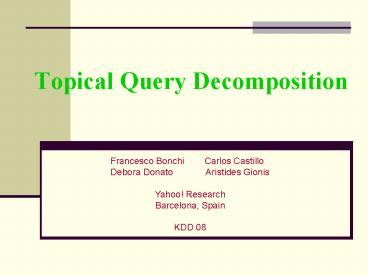Topical Query Decomposition - PowerPoint PPT Presentation
1 / 22
Title: Topical Query Decomposition
1
Topical Query Decomposition
Francesco Bonchi Carlos
Castillo Debora Donato
Aristides Gionis Yahoo! Research Barcelona,
Spain KDD 08
2
Abstract
- Given a query and a document retrieval system
- To produce a small set of queries whose union of
resulting documents corresponds approximately to
that of the original query. - Set cover problem
- Greedy algorithm
- Clustering problem
- Two-phase algorithm based on hierarchical
agglomerative clustering (dynamic programming)
3
Introduction
- A query log L
- A list of pairs lt q, D(q) gt
- q query,
- D(q) its result a set of documents that answer
query q - Q(q) the maximal set of queries pi, where for
each pi, the set D(pi) has at least one document
in common with the documents returned by q
4
(No Transcript)
5
- The goal is to compute a cover.
- Selecting a subcollection C ? Q(q7) such that it
covers almost all of D(q7)
6
Problem Statement 1/3
- Red-Blue set cover problem
- Ub1,bn, r1,rm ( for a query q )
- Bb1,bn (i.e.,
document set) - Rr1,rm (i.e., query
set) - SS1,,Sk is provided from L (query log L)
- Si ? U
- SiB blue points in Si (SiB Si ? B)
- SiR red points in Si (SiR Si ? B)
- Goal To find a subcollection C ? S that covers
many blue points of U without covering too many
red points.
7
Problem Statement 2/3
- For each query q, the candidate queries Q(q)
- For each set Si with blue and red points, its
weight is - scatter sc(Si) (coherence opposite of scatter)
8
Problem Statement 3/3
- Our goal is to find a subcollection C ? S that
covers almost all the blue points of U and has
large coherence. - More precisely, we want that C satisfies the
following properties - Cover-blue
- Not-cover-red
- Small-overlap
- Coherence
9
Greedy Algorithm 1/2
- At i-th iteration , minimizes s(S,VB,VR)
- lC, lR, lO are parameters that weight the
relative importance of the three terms. - VB blue balls were already selected at before
iterations - VR red balls were already selectedat before
iterations
D. Peleg. Approximation algorithm for the
label-covermax and red-blue set cover problem.
Journal of Discrete Algorithms, 2007
10
Greedy Algorithm 2/2
11
Integer Programming
- SiS2.Sl lt10
- Si lt 1
12
Clustering-Based Method
- Two-phase approach
- First phase all points in set B are clustered
using a hierarchical agglomerative clustering
algorithm. (CLUTO toolkit) - Second phases to match the clusters of the
hierarchy produced by the agglomerative algorithm
with the sets of S. - The main idea is to match sets of S into clusters
of G - Every node T ? G corresponds to a cluster
- T(B) be the set of points in B
13
Clustering-Based Method
Dendrogram G
14
Clustering-Based Method -Dynamic Programming -
1/2
- Complete Coverage
- for each set S ? S v.s. for each node T? G ,
- Matching score m(T, S)
- m(T) the score of the best matching set in S.
- Optimal cost of covering the points of TB with
sets in S.
15
Clustering-Based Method -Dynamic Programming -
2/2
- Partial Coverage
- lU weights the relative importance between the
two terms, the scatter cost of the sets S and the
number of uncovered points.
16
Application
- Query log L 2.9 million distinct queries
- A majority of users only looks at the first page
of results, while few users request more result
pages. - D(q) any user asking for q in the query log
navigated, and consider the set of result
documents for the query - 24 million distinct documents seen by the users
17
Application - Candidate queries for the cover
- For each query q, the candidate queries Qk(q)
18
Application - Results
- A set of 100 queries were randomly picked from
top 10,000 queries submitted by users.
- Cost of k queries
- The number of documents included outside the set
D(q) - Average numbre of queries covering each element
- Coverage after the top k candidates have been
picked
19
(No Transcript)
20
(No Transcript)
21
(No Transcript)
22
Conclusions
- A novel problem
- Topical query decomposition
- Elegant solutions
- red-blue metric set cover
- clustering with predefined clusters. (
hierarchical agglomerative clustering ) - The set-cover formulation provides solutions of
better quality - Code and data for reproducing the results shown
in Table 3 is available at - http//www.yr-bcn.es/querydecomp/ .































